商务英语阅读1 教案
- 格式:doc
- 大小:180.51 KB
- 文档页数:19
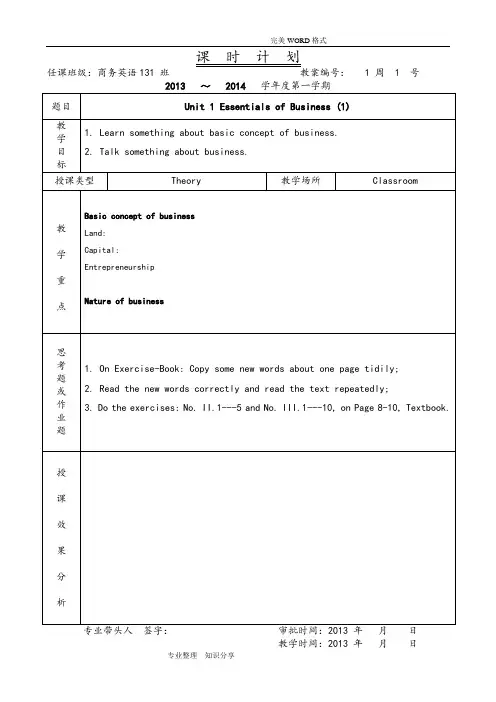
课时计划任课班级:商务英语131 班 1 周 1 号教学时间:2013 年月日Unit One Essentials of Business (1)ContentText: The Nature of BusinessDifficult Points1.Talk about some words, phrases or expressions about business;2.There are many new words in the text;3.Translate some difficult sentences of the text.Page 2: Warming-upWork with your group and think out as many words, phrases or expressions as possible about business.1) Are you interested in business? Why or not?2) What activities do you think can be labeled as business activities?3) Have you ever been involved in any business activities before?4) What do you think is important for success in today’s business world?(Teacher’s Book: Page 24)Good management, adequate planning, sufficient financial resources, healthy cash flow, controlled spending and the ability to collect money owing, effective marketing, a good product and service.Part Two: 15 minutesPage 5: New words No.1-17 to the first 6 paragraphs of the Text1. Divide the words in two groups: No.1-10; No.11-17;2. Lead the students to spell the words one by one;3. Repeat the words and play translating game;4. Mark the words in the three paragraphs and recognize them.Part Three: 30 minutesPage 2: Translate and understand the first 6 paragraphs of the Text1. Read the first 6 paragraphs silently and pay attention to the difficult points;2. Translate each sentence into Chinese and mark some language points:3. Review by reading each paragraph twice;4. Review by asking some questions: some from No. I, Page 81) What does “business” mean in the text?The key comes from Paragraph 1:It means the human activity related to material things. It’s necessary for civilization. And it is found in all societies, even the simplest ones. It’s the activity of producing and distributing goods and services.2) What are the four basic factors of production?The key comes from Paragraph 2:They are land, labor, capital, and entrepreneurship.3) What does the term “land” in this text refer?The key comes from Paragraph 3:Here, the term land is used most general way. It refers not only to a piece of real estate where we might build a factory, but it also means all the raw materials used for production.Some materials are on the earth’s surface, and some are under the surface. And some raw materials may be extracted from the air. All of the raw materials for production come from the land, the air, and the oceans.4) What does the term “labor” refer to in this passage?The key comes from Paragraph 4:It refers to the use of mental or physical work to produce goods. Most labor changes raw materials into finished products and then distributes these to buyers.5) What is the general meaning of “capital” in everyday language?The key comes from Paragraph 6:It means several things. The most general meaning is wealth or money.6)What does the term “capital” refer to according to this passage?The key comes from Paragraph 6:But it also refers to the equipment that money purchases. It’s all the things that workers use in production and distribution. It refers anything that helps to produce and distribute goods.5. Read the first 6 paragraphs together to review.Part Four: 10 minutesPage 6: New words No.18-32 to the rest 3 paragraphs of the Text1. Divide the words in two groups: No.18-28; No.29-32 with the 9 phrases;2. Lead the students to spell the words one by one;3. Repeat the words and play translating game;4. Mark the words in the paragraphs and recognize them.Part Five: 15 minutesPage 3: Translate and understand the rest three paragraphs of the Text1.Read the paragraphs silently one by one and know what are your difficult points;2.Translate each sentence into Chinese and mark some language points:3. Review by reading each paragraph twice:4. Review by asking some questions from No. 1, Page 8Questions:7)What is called entrepreneurship?The key comes from Paragraph 7:Putting together land, labor, and capital to make something of value, is called entrepreneurship8)What responsibilities should an entrepreneur take?The key comes from Paragraph 7:The entrepreneur is the person responsible for controlling and directing the other three factors. He is the leader, and the employees follow his direction.9)What kind of problems will a company cause to people when it goes bankrupt?The key comes from Paragraph 9:It means the company becomes unable to pay its debt, it causes problems for many people. It’s hard for the employees who have to seek work elsewhere; the customers must look for another place to buy the products; creditors usually lose some moneyto the company. But the entrepreneur takes the biggest risk if the business succeeds or fails. He must pay them up to the limit of his ability to pay.10) When will the entrepreneur make a profit and when will he suffer a loss?The key comes from Paragraph 9:If he is skillful and lucky, the money he receives from his business venture will pay for the land, labor, and capital and there will still be extra money remaining for him. This extra money is the profit. If the money he receives from the business venture is not enough to pay all of the costs, the difference is the loss.5. Read the rest 3 paragraphs together to review.课时计划任课班级:商务英语131 班教案编号: 1 周 2 号教学时间:2013 年月日Essentials of Business (2) I. Review the content of the passageII. Recite the passageIII. Explaining the language pointsrelate:relate something to something else 与……有关e.g. The report seeks to relate the rise in crime to an increase in unemployment. V+ ing as subject: The -ing form of the verb can be used as the subject of a sentence e.g. Seeing is believing.Taking good photos requires patience as well as keen eyes.Watching television at spare time is a good entertainment.辨析capital & money:Capital is the money or property that you use to start a business or to make more money. Money is what you earn by working and you use in order to buy things.e.g. The recycling industry is making huge capital investments in equipment.Do you have enough money to pay for the sandwiches?Therefore, collocations related with "capital" are: capital intensive industries(资本密集产业); venture/risk capital(风险资本); intellectual capital(智识资本). etc. Collocations related with "money", on the other hand. are: money bags(有钱人); Money makes a mare go.(有钱能使鬼推磨); money worshiper(金钱至上主义者). entrepreneurship:Entrepreneurship is a frequently used concept in English-speaking countries, but it is difficult to define and translate. It generally refers to a management concept characterized by development and renovation and the ability to implement this concept in marketing.(它指的是一种发展的、革新的经营观念,以及将这种观念贯彻在市场中的能力。

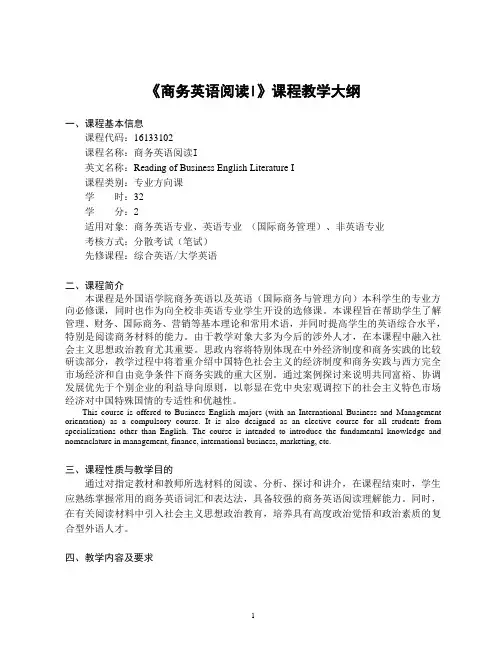
《商务英语阅读I》课程教学大纲一、课程基本信息课程代码:16133102课程名称:商务英语阅读I英文名称:Reading of Business English Literature I课程类别:专业方向课学时:32学分:2适用对象: 商务英语专业、英语专业(国际商务管理)、非英语专业考核方式:分散考试(笔试)先修课程:综合英语/大学英语二、课程简介本课程是外国语学院商务英语以及英语(国际商务与管理方向)本科学生的专业方向必修课,同时也作为向全校非英语专业学生开设的选修课。
本课程旨在帮助学生了解管理、财务、国际商务、营销等基本理论和常用术语,并同时提高学生的英语综合水平,特别是阅读商务材料的能力。
由于教学对象大多为今后的涉外人才,在本课程中融入社会主义思想政治教育尤其重要。
思政内容将特别体现在中外经济制度和商务实践的比较研读部分,教学过程中将着重介绍中国特色社会主义的经济制度和商务实践与西方完全市场经济和自由竞争条件下商务实践的重大区别。
通过案例探讨来说明共同富裕、协调发展优先于个别企业的利益导向原则,以彰显在党中央宏观调控下的社会主义特色市场经济对中国特殊国情的专适性和优越性。
This course is offered to Business English majors (with an International Business and Management orientation) as a compulsory course. It is also designed as an elective course for all students from specializations other than English. The course is intended to introduce the fundamental knowledge and nomenclature in management, finance, international business, marketing, etc.三、课程性质与教学目的通过对指定教材和教师所选材料的阅读、分析、探讨和讲介,在课程结束时,学生应熟练掌握常用的商务英语词汇和表达法,具备较强的商务英语阅读理解能力。
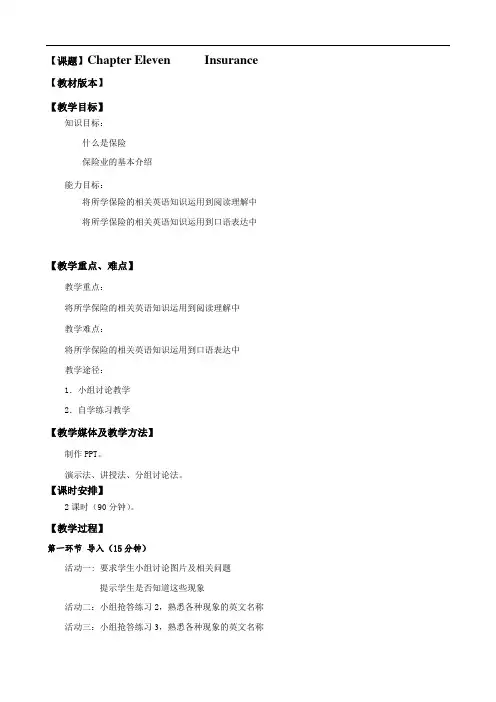
【课题】Chapter Eleven Insurance 【教材版本】【教学目标】知识目标:-什么是保险-保险业的基本介绍能力目标:-将所学保险的相关英语知识运用到阅读理解中-将所学保险的相关英语知识运用到口语表达中【教学重点、难点】教学重点:将所学保险的相关英语知识运用到阅读理解中教学难点:将所学保险的相关英语知识运用到口语表达中教学途径:1.小组讨论教学2.自学练习教学【教学媒体及教学方法】制作PPT。
演示法、讲授法、分组讨论法。
【课时安排】2课时(90分钟)。
【教学过程】第一环节导入(15分钟)活动一: 要求学生小组讨论图片及相关问题提示学生是否知道这些现象活动二:小组抢答练习2,熟悉各种现象的英文名称活动三:小组抢答练习3,熟悉各种现象的英文名称第二环节新授课(50分钟)阅读篇章A[讲解]详细讲解文章的内容列出生词和长难句[演示]教师用幻灯片演示单词和句子[问答]1 What is insurance?2 What is an insurance premium?3 What is the insurer?[问答]根据课文内容,小组抢答练习5Please pick out either the strong point or the weak point of the different kind of the shipment阅读篇章B[自学练习]学生根据课后提供的单词和句子翻译,进行自学阅读练习。
[问答]小组抢答第6题1 Do you know how to classify the Insurance companies?2 What are the differences between Life insurance companies and Property insurance companies?3 What are the differences between mutual company and stock company?[问答]小组抢答第7题第三环节课堂练习(15分钟)[情景模拟]要求学生分组讨论漫画图片,分别用presentation的方式介绍讨论结果第四环节复习小结(8分钟)How to classify the Insurance companies?What is insurance?第五环节布置作业(2分钟)默写第一篇阅读中的核心单词。
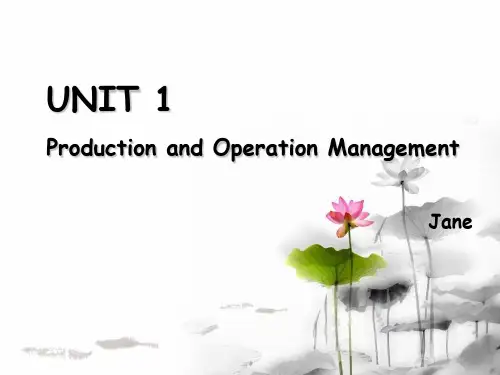
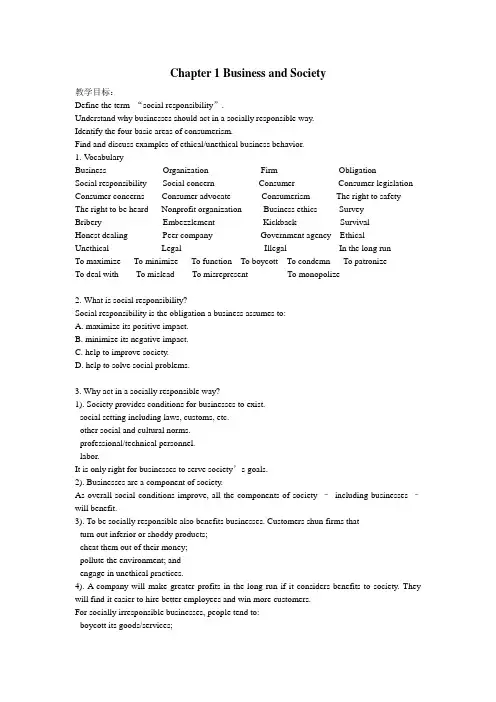
Chapter 1 Business and Society教学目标:Define the term “social responsibility”.Understand why businesses should act in a socially responsible way.Identify the four basic areas of consumerism.Find and discuss examples of ethical/unethical business behavior.1.V ocabularyBusiness Organization Firm ObligationSocial responsibility Social concern Consumer Consumer legislation Consumer concerns Consumer advocate Consumerism The right to safetyThe right to be heard Nonprofit organization Business ethics SurveyBribery Embezzlement Kickback SurvivalHonest dealing Peer company Government agency EthicalUnethical Legal Illegal In the long runTo maximize To minimize To function To boycott To condemn To patronizeTo deal with To mislead To misrepresent To monopolize2.What is social responsibility?Social responsibility is the obligation a business assumes to:A. maximize its positive impact.B. minimize its negative impact.C. help to improve society.D. help to solve social problems.3. Why act in a socially responsible way?1). Society provides conditions for businesses to exist.- social setting including laws, customs, etc.- other social and cultural norms.- professional/technical personnel.- labor.It is only right for businesses to serve society’s goals.2). Businesses are a component of society.As overall social conditions improve, all the components of society –including businesses –will benefit.3). To be socially responsible also benefits businesses. Customers shun firms that- turn out inferior or shoddy products;- cheat them out of their money;- pollute the environment; and- engage in unethical practices.4). A company will make greater profits in the long run if it considers benefits to society. They will find it easier to hire better employees and win more customers.For socially irresponsible businesses, people tend to:- boycott its goods/services;- influencing officials against it;- condemning it in the media;- buy goods/services in other firms4.ConsumerismWhat is consumerism?Consumerism is the public demand for more protection of the buyer’s rights.Right to SafetyRight to InformationRight to ChooseRight to Be heard5.Basic areas of consumerism1). The right to safety- product safe for intended use- explicit directions for use- properly tested to ensure reliability & quality2). The right to information- detailed information about ingredients- instructions for use3). The right to choose- customers having access to a variety of products/services at competitive prices- competition free to flourish4). The right to be heard- consumers’interests receiving full consideration- consumers able to appeal beyond a company6.What is ethics?Ethics is the study of morals and moral choices.7. What is business ethics?Business ethics refers to moral principles that define right and wrong behavior in the world of business.8. Ethics vs. LawWhile many ethical standards are defined by laws, the law does not cover all unethical conduct. Abiding by the law defines a minimum guide for ethical behavior.People’s ethical code is influenced by laws, culture, professional codes, and individual values.9. Business ethicsEthical business behavior:- law abiding- providing satisfactory products/services- offering reasonable prices- offering fair wages and employee benefits- raising fund for charities- protecting the environment10. Unethical business behavior:- law-defying- cheating customers- misrepresenting products/services- polluting the environment- offering bribes/kickbacks/payoffs- price-fixing11.AssignmentPresentation work:Find information from media and introduce a socially responsible/irresponsible business. Discussion topic:Do you agree with people who say “it is simply good business to be ethical”? Give your reasons.Chapter 2 Forms of Business Ownership (1)教学目标:Understand the nature of sole proprietor-ships and partnerships.Describe the advantages and disadvantages of sole proprietor-ships.Describe the advantages and disadvantages of partnerships.1.V ocabularySole proprietor-ship Partnership General partnership General partner Limited Partnership Limited Partner Partnership Agreement Partnership Interest Joint Venture Limited Liability Unlimited Liability Personal Income Tax Creditor Credit Rating Personal Assets LicenseSole Proprietor-ships2. What is a sole proprietorship?A sole proprietorship is a business owned by one person. It is a typically small business.- restaurants- beauty parlors- flower shops- newsstands3.Advantages of a sole proprietorshipEasy to start and easy to close.Direct and complete control.Greater motivation.Easy to keep trade secrets.Fewer and lower taxes (compared with incorporated companies).4. Disadvantages of a sole proprietorshipUnlimited liability –all of owner’s assets are potentially at risk.Limited sources of funds.Limited management skills.Partnerships5.What is a partnership?A partnership is a business owned by two or more persons. It has 3 basic types: general partnership, limited partnership, and joint venture.6.Three types of partnership1). General partnershipAll partners have unlimited liability.2). Limited partnershipat least 1 general partner + at least 1 limited partner (who does not participate in the management of the business)3). Joint ventureestablished for a specific project7.Advantages of a partnershipEasy to start or organize.Partners may specialize in different areas of business management.Additional capital injected by each partner.Losses shared between the partners.Incentive for key employees.8.Disadvantages of a partnershipUnlimited liability.Profits are shared.Short length of life in the event of the death of one of the partners.All partners are bound by the decision of any one of them - owner conflict;Difficulty in withdrawing.9.AssignmentPresentation work:Tell people how you plan to start a small business after you graduate.Discussion topic:Compare a sole proprietorship with a partnership and discuss their respective advantages and disadvantages.Chapter 3 Forms of Business Ownership (2)教学目标:Understand the nature of a corporation and its advantages and disadvantages.Describe how a corporation is created and managed.Understand how the form of organization affects (1) taxes, (2) the distribution of profits, (3) the ownership and control of a business, and (4) the liabilities of business owners.1.V ocabularyCorporation Private Corporation Public Corporation Corporate Charter Corporate Bylaw Corporate Officers Incorporator ProspectusLegal entity Legal being Artificial Being Shareholder2. What is a corporation?A corporation is a legal body created by the state. As a legal body, it is able:- to buy, own, and transfer property;- to enter into contracts with individuals or with other legal bodies;- to sue or be sued in its own name.3. Private and public corporationsA private corporation is one that has only a few shareholders.Private corporations do not have to:- produce financial reports to the public;- go through complex procedures to make decisions;- hold public stockholder meetings.mon stock vs. preferred stockCommon stock- Anyone can buy and sell shares of common stock.- Owners have a right to vote on the company’s board of director.- Owners are entitled to receive dividend payments.Preferred stock- Owners get preference in the distribution of the company’s earnings.- Owners receive a fixed dividend before common stockholders receive any dividends.- Owners usually do not have the right to vote on the company’s board of directors.5.Management of CorporationsBoard of directors: to ensure that the objectives of the corporation are achieved on schedule. Corporate officers: responsible to the board of directors for the management and daily operations of the firm.6.Advantages of a corporationLimited liability;Ease of transferring ownership;Continuous life;Ease of attracting capital;Large size.7.Disadvantages of a corporationGovernment regulations;Higher taxes;Lack of personal interest;Lack of secrecy;Rigid structure;Difficulty in creating.8. AssignmentPresentation workSelect a corporation and tell people its major features.Discussion topicWould you like to work in a sole proprietorship, a partnership, or a corporation? Give your reasons.Chapter 4 Management Principles教学目标:Define management and understand its role in achieving organizational objectives.Identify three levels of management and explain how the focuses of managers at each level differ. Describe the major functions of management.1.V ocabularyManagement Manager Top Management Middle Management First-line Management Planning Long-range Planning Short-range Planning Strategic Plans Tactical Plans Organizing Staffing2. What is an organization?An organization is any group of individuals who work together for the achievement of some stated or implied objectives.Two major types of organization:- business organization- nonprofit organization3.What resources do organizations have?To achieve its objectives, every organization must have resources, which generally fall into three types.- human resources: people (employees)- physical resources: equipment, machinery, raw materials, etc.- financial resources: money and other valuable assets4.What is management?Management is the process of coordinating human, physical, and financial resources to achieve an organization’s objectives.Management and managers are found wherever people are working together to achieve some common objectives.5.Top managementHaving overall responsibility for the organization.Concentrating on making strategic decisions or “doing the right thing”.Top managers generally have many years of varied experience.6. Middle managementResponsible for certain areas, departments or divisions.Making plans to implement strategic decisions made by top management (doing things right). Making operating plans for their particular area.7. First-line ManagementResponsible for implementing plans established by middle management.Supervising workers and managing day-to-day operations.Providing leadership that is appropriate for the situation.8. Functions of management1). Planning: selecting a course of action- Strategic plans: long-range plans- Tactical plans: short-range plans2). Organizing: structuring of resources- dividing work into small units- assigning tasks to individuals or groups- arranging jobs into specific departments- establishing lines of authority and accountability3). Staffing: hiring people to do work- Recruiting: attracting qualified applicants- Selection: choosing the best candidate4). Directing: motivating and leading employees to achieve objectives5).Controlling: evaluating and correcting activities to keep the organization on course- Measuring the performance.- Comparing performance with standards.- Identifying deviations from standards.- Investigating causes of deviations.- Taking corrective actions if necessary.9.AssignmentPresentation workSupposing you are a divisional manager of a large corporation, tell people about your work. Discussion topicWhat different personal qualities / background should people at top / middle / first-line management have?Chapter 5 Managerial Skills and Managers教学目标:Identify the three styles of leadership.Describe the skills managers need in order to be successful.Describe how organizations acquire managers.Discuss some effective ways of achieving good communication within an organization.1.V ocabularyManagerial Skill Styles of Leadership Autocratic Leaders Democratic Leaders Free-rein leaders Style Flexibility Technical Skills Conceptual Skills Human Skills MBA Internal Promotions RoutineSpecific Productivity Morale FeedbackCredibility Annual Performance2. Leadership and styles of leadershipLeadership is the ability to influence employees to work toward the achievement of organizational goals.Three basic styles of leadership:- autocratic- democratic- free-rein3. Autocratic leadersMaking all the decisions;Directing and commanding subordinates;Dogmatic and task-oriented;Total disregard for what employees might think;Effective when employees are unskilled or unmotivated.4.Democratic leadersPaying attention to opinions and ideas from staff.Making decisions together with subordinates;More open, cooperative, and supportive than autocratic leaders;Effective when employees are skilled and motivated.5.Free-rein leadersLetting their employees work without much interference;Showing a great deal of trust and confidence in the employees;Effective when employees are highly skilled and fully motivated to achieve their goals.6.Managerial skillsManagers need technical skills to- perform a job;- communicate effectively with subordinates and superiors;- gain credibility.7. Conceptual skills are necessary for managers to- think in abstract terms;- see how parts form the whole;- promote creative thinking;- develop a long-term perspective.8. Human skills, also referred to as people skills or human relation skills, are needed to - get along well with people;- deal with people effectively;- generate confidence and commitment;- create a sound work environment.9.Where do managers come from?Promoting from withinAdvantages:- increasing motivation- building company loyalty- new managers familiar with the companyDisadvantages:- few or no new ideas- making innovations difficult10. Where do managers come from?Hiring from withoutAdvantages:- bringing fresh ideas- promoting innovationDisadvantages:- difficult to find suitable people- internal resentment11. Better management communicationGuidelines for managers to communicate better1. Communicate your overall purpose.2. Communicate your expectation.3. Provide feedback on performance.4. Communicate all changes.5. Communicate face to face.12. AssignmentPresentation work1. Create situations to illustrate effective use of different styles of leadership.2. If you were the head of a department, how would you communicate with those above you (your superiors) and those under you (your subordinates)?Chapter 6 Corporate Culture教学目标:Define the term “corporate culture”.Describe the various elements of corporate culture.Explain the importance of developing a strong corporate culture.Describe the role played by the hero, the storyteller and the priest.1.V ocabularyCorporate Culture Organizational Culture Esprit de Corps Sense of Identity Sense of Togetherness Shared Values Organizational Motto Role models Number 1 Rule Informal system of rules Bureaucracy Company Uniform2.What is specializationSpecialization = division of labor- dividing work into small, specialized tasks- assigning employees to do a single task3.Why is specialization important?Specialization is important because it- raises efficiency;- minimizes time lost when workers have to perform more than one task;- enables use of specialized equipment;- simplifies training.Negative effects: Workers may become bored and dissatisfied with their jobs.4. What is delegation of authority?Delegation of authority means:- assigning tasks to employees- allowing them to use resources to accomplish the tasks- making them accountable for proper execution of the work5.Reasons for delegation of authority- As a company grows, it is impossible for one manager or owner to do everything.- Delegation frees the manager to attend to other matters.6.Centralization vs. DecentralizationCentralization means that top-level managers delegate very little authority to the lower levels. Reasons for centralization:- Decisions to be made are risky.- Low-level managers are not skilled in decision making.Decentralization means that decision making power is delegated to the lower levels of the organization.Reasons for decentralization:- Companies operate in complex and unpredictable situations.- Lower-level managers have strong decision making skills.7.What is departmentalization?Departmentalization refers to grouping of jobs into units called departments, units, groups or divisions.Departments are commonly organized by function, products, territory or customer.8.Ways of DepartmentalizationBy function- grouping of jobs according to business function such as production, marketing, finance, etc.;- each department managed by an expert;- each manager needs only skills related to his/her department;By product- grouping of jobs around the products of the firm;- functional activities located within each product division;- coordination and decision making becoming easier;- duplication or redundancy of functional departments.- conflict between departments may affect the whole organization.By territory- grouping of jobs by geographic location;- able to cope with vast differences between territories and respond to unique requirements of each area;- requiring more administrative staff to coordinate operations.By customer- grouping of jobs around the needs of various types of customers;- easy to respond to different needs of different customer groups;- requiring more administrative staff to coordinate operations.9. AssignmentPresentation work1. Select a company and tell people about its organizational structure.2. Find examples to illustrate the four different ways of departmentalization.Chapter 7 Business Organization and Structure教学目标:Explain the importance of job specialization to an organization.Explain the concept of accountability.Compare the advantages and disadvantages of centralization and decentralization.Identify four types of departmentalization.1.V ocabularySpecialization Division of Labor Specialized Task Specialized Equipment Organizational Structure Centralization Decentralization Extent of Centralization Centralized Organization Decentralized Organization DepartmentalizationFunctional Departmentalization Product Departmentalization Territorial Departmentalization Customer Departmentalization Superior Authority Delegation of Authority Administrative Staff2. What is specializationSpecialization = division of labor- dividing work into small, specialized tasks- assigning employees to do a single task3.Why is specialization important?Specialization is important because it- raises efficiency;- minimizes time lost when workers have to perform more than one task;- enables use of specialized equipment;- simplifies training.Negative effects: Workers may become bored and dissatisfied with their jobs.4. What is delegation of authority?Delegation of authority means:- assigning tasks to employees- allowing them to use resources to accomplish the tasks- making them accountable for proper execution of the work5.Reasons for delegation of authority- As a company grows, it is impossible for one manager or owner to do everything.- Delegation frees the manager to attend to other matters.6.Centralization vs. DecentralizationCentralization means that top-level managers delegate very little authority to the lower levels. Reasons for centralization:- Decisions to be made are risky.- Low-level managers are not skilled in decision making.Decentralization means that decision making power is delegated to the lower levels of theorganization.Reasons for decentralization:- Companies operate in complex and unpredictable situations.- Lower-level managers have strong decision making skills.7.What is departmentalization?Departmentalization refers to grouping of jobs into units called departments, units, groups or divisions.Departments are commonly organized by function, products, territory or customer.8.Ways of DepartmentalizationBy function- grouping of jobs according to business function such as production, marketing, finance, etc.;- each department managed by an expert;- each manager needs only skills related to his/her department;By product- grouping of jobs around the products of the firm;- functional activities located within each product division;- coordination and decision making becoming easier;- duplication or redundancy of functional departments.- conflict between departments may affect the whole organization.By territory- grouping of jobs by geographic location;- able to cope with vast differences between territories and respond to unique requirements of each area;- requiring more administrative staff to coordinate operations.By customer- grouping of jobs around the needs of various types of customers;- easy to respond to different needs of different customer groups;- requiring more administrative staff to coordinate operations.9.AssignmentPresentation work1. Select a company and tell people about its organizational structure.2. Find examples to illustrate the four different ways of departmentalization.Chapter 8 Products教学目标:Define the term product and classify products.Describe the research and development process of new products.Describe the product life cycle and discuss how it relates to product planning.1.V ocabularyProduct Tangible Product Intangible Product Consumer Product Industrial Product Competing Product Sample Product Potential ProductLife Cycle of a Product Introduction Growth MaturityDecline Potential Profitability Marketing Mix PromotionPromotion Cost Gross National Product Research and Development2. What is a product?The term product generally refers to goods and services which provide use or satisfaction.1). Goods- made or manufactured- tangible and have utility- can be divided into consumer products (for household or family use) and industrialproducts (for industrial use).2). Services- tangible (haircut, car wash, etc.)- intangible (service provided by lawyers, consultants, etc.)- generating jobs- contributing much to a country’s GNP3. New product developmentFor companies, developing new products is both important and risky. It usually goes through the following steps.1). Developing new ideas;2). Screening new ideas;3). Market research;4). Product development (on a limited scale);5). Test marketing;6). Commercialization.4.Product life cycleLike human beings, products are born; they grow, they mature, and eventually they die. Many of them go through four stages.- Introduction- Growth- Maturity- Decline5.Product life cycle - introduction- product new to the public;- sales unstable and company losing money;- prices high because of development and promotion costs;- sales moving up from zero;- profits moving from below zero to break- even point.6.Product life cycle - growth- Sales and profits rise rapidly.- Prices remain high in the beginning to recover heavy introduction loses.- Prices decline in later period because of competition.- Product is constantly improved.- Company tries hard to expand market.7.Product life cycle - maturity-Growth stabilizes and eventually slows down.- Competition becomes intense, forcing prices to g o down and become relatively stable.- Customer loyalty is established to ensure limited sales.8.Product life cycle - decline- Product fades as it is replaced by something new.- Businesses begin to cut promotion cost and withdraw from the market.- Some products may linger because of strong brand loyalties, while less identified products disappear quickly.9. AssignmentPresentation workFind examples among products you are familiar with to illustrate the four different stages of product life cycle.Discussion topicDiscuss how each stage of product life is related to a company’s sales and profits.Chapter 9 Pricing教学目标:Define pricing and understand its importance in marketing.Describe various pricing objectives a firm might employ.Relate the elements of demand, cost, and profit to pricing policies.1.V ocabularyPricing Pricing Decision Pricing Objectivity Pricing FlexibilityPricing Policy Skimming Pricing Penetration Pricing Odd PricingPrestige Pricing Psychological Pricing Special Rates Price StabilityProfit Maximization Sales V olume Sales Maximization BarterElastic Demand Inelastic Demand Brand Loyalty Purchasing Power2.What is price?Price is the value placed on an object involved in an exchange between a buy and a seller.- usually set by the seller- often changed/negotiated through interaction between buyer and seller。
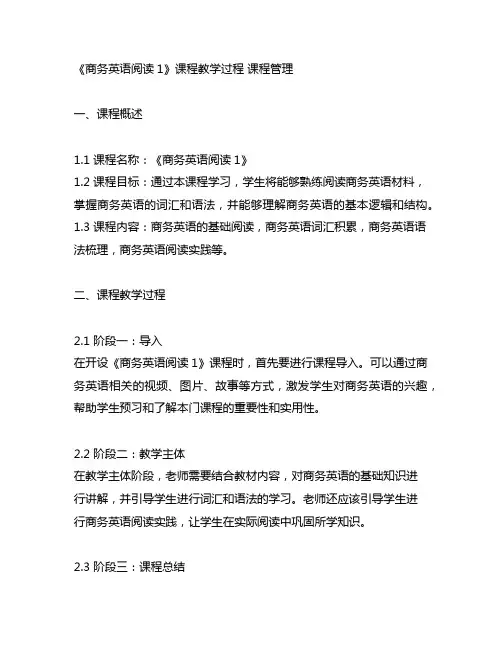
《商务英语阅读1》课程教学过程课程管理一、课程概述1.1 课程名称:《商务英语阅读1》1.2 课程目标:通过本课程学习,学生将能够熟练阅读商务英语材料,掌握商务英语的词汇和语法,并能够理解商务英语的基本逻辑和结构。
1.3 课程内容:商务英语的基础阅读,商务英语词汇积累,商务英语语法梳理,商务英语阅读实践等。
二、课程教学过程2.1 阶段一:导入在开设《商务英语阅读1》课程时,首先要进行课程导入。
可以通过商务英语相关的视频、图片、故事等方式,激发学生对商务英语的兴趣,帮助学生预习和了解本门课程的重要性和实用性。
2.2 阶段二:教学主体在教学主体阶段,老师需要结合教材内容,对商务英语的基础知识进行讲解,并引导学生进行词汇和语法的学习。
老师还应该引导学生进行商务英语阅读实践,让学生在实际阅读中巩固所学知识。
2.3 阶段三:课程总结在《商务英语阅读1》课程的最后阶段,老师应该对本门课程的教学内容进行总结。
可以结合学生的学习情况,做出适当的反馈和评价,并展望下一个学习阶段的目标和内容,为学生的学习之路指明方向。
三、课程管理3.1 学习资源管理为了保证《商务英语阅读1》课程的高效进行,学校需要提供足够的学习资源。
包括教学用书、多媒体设备、阅读材料等,以便学生能够在良好的学习环境中进行学习和实践。
3.2 教学活动管理课程管理还需要对教学活动进行有效管理。
老师应该制定详细的教学计划和教学日程,保证每个教学环节都能得到充分的利用,并对学生的学习进行及时的跟踪和督促。
3.3 学生评价管理《商务英语阅读1》课程的学习成果需要进行及时的评价。
学校可以通过考试、作业、阶段性测验等方式对学生进行评价,及时发现学生存在的问题,并进行帮助和指导,推动学生的学习进展。
四、个人观点作为一门商务英语基础课程,《商务英语阅读1》的教学过程和课程管理对于学生的学习十分关键。
在这门课程中,学校和老师需要合理运用各种教学资源,制定出合理的教学计划,并积极对学生进行评价和指导,以便学生能够在学习过程中不断提高,达到预期的学习目标。

商务英语阅读教案Lesson 1一、教学目标1. 知识目标掌握商务英语阅读的基本技巧。
了解商务英语中常见的术语和表达方式。
学习商务英语文章的常见结构。
2. 技能目标提高学生的商务英语阅读理解能力。
培养学生运用商务英语进行阅读和交流的能力。
训练学生快速获取商务信息的能力。
3. 情感目标激发学生对商务英语阅读的兴趣。
培养学生的团队合作精神。
二、教学内容1. 商务英语阅读技巧介绍。
2. 商务英语中常见的术语和表达方式。
3. 商务英语文章的常见结构。
三、教学方法1. 讲授法:讲解商务英语阅读技巧,介绍商务英语中常见的术语和表达方式。
2. 案例分析法:分析商务英语文章的常见结构。
3. 小组讨论法:学生分组阅读商务英语文章,讨论并总结文章结构。
四、教学步骤1. 导入:简要介绍商务英语阅读的重要性。
2. 讲解:讲解商务英语阅读技巧,介绍商务英语中常见的术语和表达方式。
3. 案例分析:分析商务英语文章的常见结构。
4. 小组讨论:学生分组阅读商务英语文章,讨论并总结文章结构。
5. 总结:总结本节课所学内容,布置作业。
五、作业1. 课后阅读一篇商务英语文章,总结文章结构。
2. 复习本节课所学的商务英语阅读技巧,并进行练习。
商务英语阅读教案Lesson 2(请按照上述格式,继续编写Lesson 2至Lesson 5的教案内容。
)六、教学内容1. 商务英语文章的阅读策略。
2. 提高阅读速度和理解力的技巧。
3. 商务英语文章中图表和数据的理解。
七、教学方法1. 演示法:展示如何有效地阅读商务英语文章。
2. 实践法:通过实际阅读练习来提高学生的阅读技巧。
3. 反馈法:为学生提供阅读后的反馈,帮助他们改进。
八、教学步骤1. 复习:回顾上一节课所学的商务英语阅读技巧。
2. 文章阅读:学生阅读一篇商务英语文章,注意阅读策略的运用。
3. 小组讨论:学生分组讨论文章中的图表和数据,分享理解心得。
4. 速度挑战:进行阅读速度挑战,学生尝试在规定时间内完成阅读。
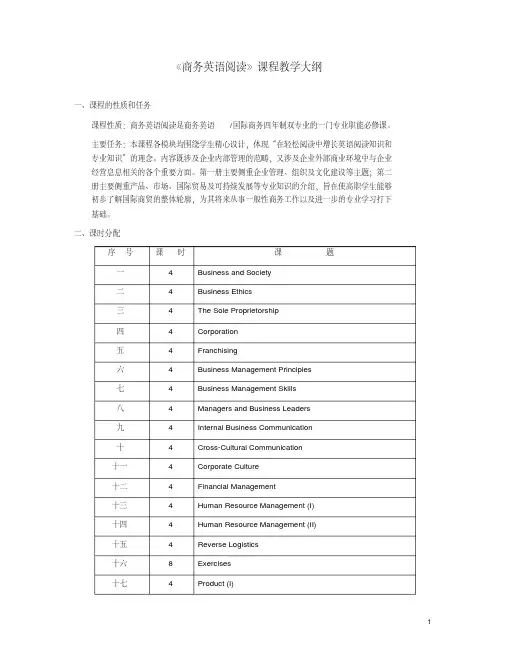
《商务英语阅读》课程教学大纲一、课程的性质和任务课程性质:商务英语阅读是商务英语/国际商务四年制双专业的一门专业职能必修课。
主要任务:本课程各模块均围绕学生精心设计,体现“在轻松阅读中增长英语阅读知识和专业知识”的理念。
内容既涉及企业内部管理的范畴,又涉及企业外部商业环境中与企业经营息息相关的各个重要方面。
第一册主要侧重企业管理、组织及文化建设等主题;第二册主要侧重产品、市场、国际贸易及可持续发展等专业知识的介绍,旨在使高职学生能够初步了解国际商贸的整体轮廓,为其将来从事一般性商务工作以及进一步的专业学习打下基础。
二、课时分配序号课时课题一 4 Business and Society二 4 Business Ethics三 4 The Sole Proprietorship四 4 Corporation五 4 Franchising六 4 Business Management Principles七 4 Business Management Skills八 4 Managers and Business Leaders九 4 Internal Business Communication十 4 Cross-Cultural Communication十一 4 Corporate Culture十二 4 Financial Management十三 4 Human Resource Management (I)十四 4 Human Resource Management (II)十五 4 Reverse Logistics十六8 Exercises十七 4 Product (I)十八 4 Product (II)十九 4 Pricing二十 4 Marketing (I)二十一 4 Marketing (II)二十二 4 Electronic Commerce二十三 4 Accounting and Financial Statements二十四 4 Insurance二十五 4 Business Law二十六 4 International Trade (I)二十七 4 International Trade (II)二十八 4 Sustainable Development二十九 4 Business Organization三十 4 International Business Organization三十一 4 Globalization三十二8 Exercises三十三 4 Review三十四 4 Test三十五 4 机动三、课程教学内容Unit 1.重点:Business and Society难点:relationship between business and society; responsibility of business in society; principles of global corporate responsibilityUnit 2.重点:Business Ethics难点:definition of business ethics; four broad themes of business ethics; business ethics in everyday businessUnit 3.重点:The Sole Proprietorship难点:definition of a sole proprietorship; starting a business as a sole proprietorship; advantages of doing business as a sole proprietor重点:Corporation难点:definition of corporation; advantages of operating a corporation; operation of a corporation Unit 5.重点:Franchising难点:definition of franchising; operation of franchising; history and development of franchising Unit 6.重点:Business Management Principles难点:definition of management; basic principles of management; process of management by objectivesUnit 7.重点:Business Management Skills难点:importance of managerial effectiveness; differences between effectiveness and efficiency; time management and its skillsUnit 8.重点:Managers and Business Leaders难点:definitions of business managers and leaders; differences between a manager and a leader in business; managers’ effective communication skillsUnit 9.重点:Internal Business Communication难点:overview of internal communication; three channels of effective communication; main objectives of internal communication mechanisms; principles of strategic organizational communicationsUnit 10.重点:Cross-Cultural Communication难点:definition of culture; implications of culture shock; cross-cultural communication challenges; benefits of corporate diversityUnit 11.重点:Corporate Culture难点:definition of corporate culture; dimensions of corporate cultureUnit 12.重点:Financial Management难点:three decisions involved in financial management; operation of financial marketsUnit 13.重点:Human Resource Management (I)难点:definition of strategic human resource management; roles of strategic human resource managers; employee motivationUnit 14.重点:Human Resource Management (II)难点:purposes of performance appraisal; benefits of performance appraisal重点:Reverse Logistics难点:definition of reverse logistics as a process; reverse logistics activities; improving ROA through effective returns managementUnit 16.重点:Product (I)难点:definition of product; types of product; product life cycleUnit 17.重点:Product (II)难点:process of developing new products; importance of naming new productsUnit 18.重点:Pricing难点:definition of price; price in the marketing mix; pricing objectives and strategiesUnit 19.重点:Marketing (I)难点:definition of marketing; product conception; product promotionUnit 20.重点:Marketing (II)难点:definition of brand; benefits of branding; features of a brand nameUnit 21.重点:Electronic Commerce难点:differences between traditional commerce and e-commerce; advantages and disadvantages of e-commerce; future development of e-commerceUnit 22.重点:Accounting and Financial Statements难点:definition of the balance sheet; interpreting the balance sheet; functions of the balance sheetUnit 23.重点:Insurance难点:definition of insurance; reasons for insurance; types of insuranceUnit 24.重点:Business Law难点:definition of business law; contract, breach of contract and dispute resolution; intellectual propertyUnit 25.重点:International Trade (I)难点:definition of international trade; advantages of international trade; forms of international trade重点:International Trade (II)难点:trade barriers in international trade; international cooperation and negotiationUnit 27.重点:Sustainable Development难点:definition of sustainable development; conflict and synthesis of sustainable development;actions for a country or corporation to achieve sustainable developmentUnit 28.重点:Business Organization难点:definition of business organization; forms of organizational structure; definition of virtual organization; four types of virtual organizationUnit 29.重点:International Business Organization难点:definition of international business organization; a brief introduction to WTO and ICC;past, present and future of the multilateralismUnit 30.重点:Globalization难点:main reasons for globalization; benefits of globalization; the antiglobalization movement四、课程教学的基本要求教学环节包括:课堂讲授及习题课、课外作业、考试考查等。
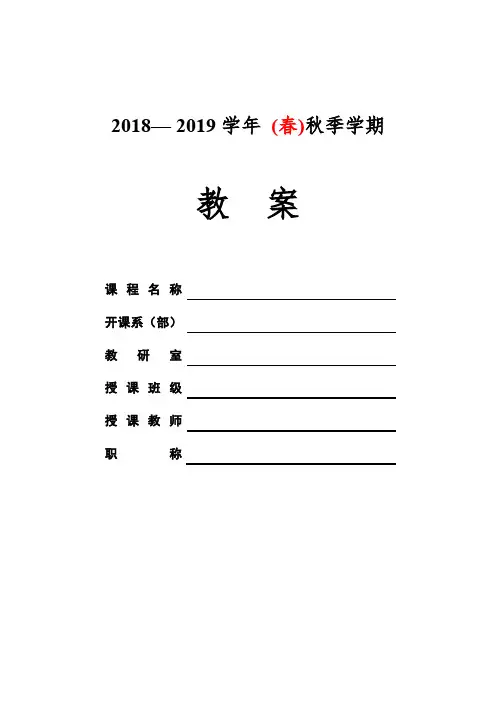
2018— 2019学年(春)秋季学期教案课程名称开课系(部)教研室授课班级授课教师职称课程基本情况(简单介绍本课程的总体目标和要求)Unit 1 Western Cultures1、2课时教案注:mins=minutes3、4课时教案5、6课时教案Unit 2 Making Introductions1、2课时教案注:mins=minutes3、4课时教案5、6课时教案Unit 3 Telephone Etiquette1、2课时教案注:mins=minutes3、4课时教案5、6课时教案lack 不是形容词,因此没有be lack of的用法。
lacking adj.☆ He was lacking in confidence. 他缺乏自信。
therebyadv. [formal] as a result of this action因此,从而☆ Diets that are high in saturated fat and cholesterol tend to clog up our arteries, thereby reducing the blood flow to our hearts and brains.饱和脂肪和胆固醇含量高的饮食会阻塞动脉,从而减少流向心脏和大脑的血液。
☆ He wished to travel and thereby study the customs of other countries.他希望去旅游,从而研究其他国家的民俗风情。
4. Add to this the typical hectic pace of business communication, and you have a particularly difficult situation.this指代前一句话提到的状况;the typical hectic pace of business communication 是add的宾语,由于太长,所以后置;句中and表示条件和结果,在祈使句后,常用and连接一个简单句,表示条件与结果的关系,它们在语法上是并列关系,但在意义上却是主从关系,也可译为“如果……就……”。
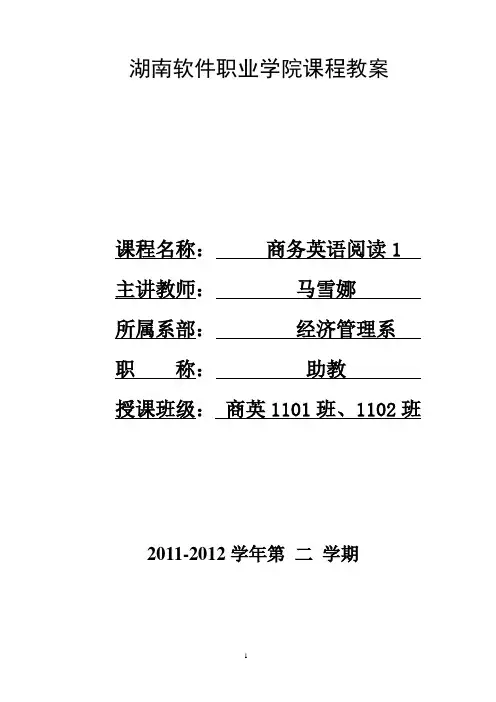
课时计划任课班级:商务英语131 班教案编号: 1 周 1 号教学时间:2013 年月日Unit One Essentials of Business (1)ContentText: The Nature of BusinessDifficult Points1.Talk about some words, phrases or expressions about business;2.There are many new words in the text;3.Translate some difficult sentences of the text.Page 2: Warming-upWork with your group and think out as many words, phrases or expressions as possible about business.1) Are you interested in business? Why or not?2) What activities do you think can be labeled as business activities?3) Have you ever been involved in any business activities before?4) What do you think is important for success in today’s business world?(Teacher’s Book: Page 24)Good management, adequate planning, sufficient financial resources, healthy cash flow, controlled spending and the ability to collect money owing, effective marketing, a good product and service. Part Two: 15 minutesPage 5: New words No.1-17 to the first 6 paragraphs of the Text1. Divide the words in two groups: No.1-10; No.11-17;2. Lead the students to spell the words one by one;3. Repeat the words and play translating game;4. Mark the words in the three paragraphs and recognize them.Part Three: 30 minutesPage 2: Translate and understand the first 6 paragraphs of the Text1. Read the first 6 paragraphs silently and pay attention to the difficult points;2. Translate each sentence into Chinese and mark some language points:3. Review by reading each paragraph twice;4. Review by asking some questions: some from No. I, Page 81) What does “business” mean in the text?The key comes from Paragraph 1:It means the human activity related to material things. It’s necessary for civilization. And it is found in all societies, even the simplest ones. It’s the activity of producing and distributing goods and services.2) What are the four basic factors of production?The key comes from Paragraph 2:They are land, labor, capital, and entrepreneurship.3) What does the term “land” in this text refer?The key comes from Paragraph 3:Here, the term land is used most general way. It refers not only to a piece of real estate where we might build a factory, but it also means all the raw materials used for production.Some materials are on the earth’s surface, and some are under the surface. And some raw materials may be extracted from the air. All of the raw materials for production come from the land, the air, and the oceans.4) What does the term “labor” refer to in this passage?The key comes from Paragraph 4:It refers to the use of mental or physical work to produce goods. Most labor changes raw materials into finished products and then distributes these to buyers.5) What is the general meaning of “capital” in everyday language?The key comes from Paragraph 6:It means several things. The most general meaning is wealth or money.6)What does the term “capital” refer to according to this passage?The key comes from Paragraph 6:But it also refers to the equipment that money purchases. It’s all the things that workers use in production and distribution. It refers anything that helps to produce and distribute goods.5. Read the first 6 paragraphs together to review.Part Four: 10 minutesPage 6: New words No.18-32 to the rest 3 paragraphs of the Text1. Divide the words in two groups: No.18-28; No.29-32 with the 9 phrases;2. Lead the students to spell the words one by one;3. Repeat the words and play translating game;4. Mark the words in the paragraphs and recognize them.Part Five: 15 minutesPage 3: Translate and understand the rest three paragraphs of the Text1.Read the paragraphs silently one by one and know what are your difficult points;2.Translate each sentence into Chinese and mark some language points:3. Review by reading each paragraph twice:4. Review by asking some questions from No. 1, Page 8Questions:7)What is called entrepreneurship?The key comes from Paragraph 7:Putting together land, labor, and capital to make something of value, is called entrepreneurship8)What responsibilities should an entrepreneur take?The key comes from Paragraph 7:The entrepreneur is the person responsible for controlling and directing the other three factors. He is the leader, and the employees follow his direction.9)What kind of problems will a company cause to people when it goes bankrupt?The key comes from Paragraph 9:It means the company becomes unable to pay its debt, it causes problems for many people. It’s hard for the employees who have to seek work elsewhere; the customers must look for another place to buy the products; creditors usually lose some money to the company. But the entrepreneur takes the biggest risk if the business succeeds or fails. He must pay them up to the limit of his ability to pay.10) When will the entrepreneur make a profit and when will he suffer a loss?The key comes from Paragraph 9:If he is skillful and lucky, the money he receives from his business venture will pay for the land, labor, and capital and there will still be extra money remaining for him. This extra money is the profit. If the money he receives from the business venture is not enough to pay all of the costs, the difference is the loss.5. Read the rest 3 paragraphs together to review.课时计划任课班级:商务英语131 班教案编号: 1 周 2 号教学时间:2013 年月日Essentials of Business (2)I. Review the content of the passageII. Recite the passageIII. Explaining the language pointsrelate:relate something to something else 与……有关e.g. The report seeks to relate the rise in crime to an increase in unemployment.V+ ing as subject: The -ing form of the verb can be used as the subject of a sentencee.g. Seeing is believing.Taking good photos requires patience as well as keen eyes.Watching television at spare time is a good entertainment.辨析capital & money: Capital is the money or property that you use to start a business or to make more money. Money is what you earn by working and you use in order to buy things.e.g. The recycling industry is making huge capital investments in equipment.Do you have enough money to pay for the sandwiches?Therefore, collocations related with "capital" are: capital intensive industries(资本密集产业); venture/risk capital(风险资本); intellectual capital(智识资本). etc.Collocations related with "money", on the other hand. are: money bags(有钱人); Money makes a mare go.(有钱能使鬼推磨); money worshiper(金钱至上主义者).entrepreneurship:Entrepreneurship is a frequently used concept in English-speaking countries, but it is difficult to define and translate. It generally refers to a management concept characterized by development and renovation and the ability to implement this concept in marketing.(它指的是一种发展的、革新的经营观念,以及将这种观念贯彻在市场中的能力。
“商务英语阅读1”课程教学大纲教研室主任:高歌执笔人:毛慧洁一、课程基本信息开课单位:曲阜师范大学外国语学院课程名称:商务英语阅读1课程编号:英文名称:Business English Extensive Reading 1课程类型:专业限选课总学时:68 理论学时:68 实验学时:0学分:4开设专业:英语先修课程:无二、课程任务目标(一)课程任务本课程是英语国际商务方向的一门专业限选课,是使学生大量接触商务英语类文章和培养阅读能力的一门基础课。
本课程的基本任务是通过教师引导,通过较大量的阅读,使学生掌握商务英语的基本词汇及其表达方式,获得有关商务的基本知识,懂得一般的商务表达,熟悉主要的商务英语文章类型,提高英语阅读能力和实际运用商务英语的能力,为进一步学习后续的商务英语课程,毕业后成为适应社会需要的应用型涉外商务工作者打下坚实的基础。
(二)课程目标培养学生的英语阅读理解能力和提高学生的阅读速度;培养学生细致观察语言的能力以及假设、判断、分析、归纳、推理、检验等逻辑思维能力;并通过阅读训练帮助学生扩大阅读量,吸收语言和文化背景知识。
在学完本课程后,学生应该能够:1. 熟悉主要商务英语文章的类型。
2. 能读懂主要英语报刊、杂志上面有关商务活动的较简单的报道和评论。
3. 能将一般性英语商务材料译成汉语,要求译文符合原义,行文顺畅。
4. 能基本读懂英文原版商务教科书有关章节的大意。
三、教学内容和要求Unit 1 Text A Business and Your Life了解商务与日常生活的关系,理解个人需求的三个类别,掌握长难句的翻译。
教学重点是商务词汇及短语的掌握,难点是长难句结构分析及翻译。
Unit 1 Text B Competition in Business了解竞争的优点及缺点,理解供应与需求的关系及对市场的影响,掌握长难句的翻译。
教学重点是商务词汇及短语的掌握,难点是长难句结构分析及翻译。
教案-商务英语阅读I-Unit4-叶兴国五篇范文第一篇:教案-商务英语阅读I-Unit 4-叶兴国Unit 4 Teaching Objectives: 1.To remember and use new words and expressions;2.To have general ideas of “personal brand”;3.T o learn how to polish up one’s brand;4.To know about the word formations of Business English vocabulary.Focuses:1.To have general ideas of “personal brand”;2.T o learn how to polish up one’s brand.Difficulties:How to use word formations of Business English vocabulary to improve reading ability.Teaching Time: 2 periods.Teaching Procedures:Part I Pre-reading Questions It can be used as lead-in questions.For students, they can discuss with each other and will have free answers.Part II Extensive Reading In this part, there are two texts and their relevant exercises.By reading the texts in limited time, Teacher helps students understand the contents and the reading methods to build reading abilities gradually.1.Text A Brain-twisting Job Interview Questions by Microsoft a.Let the students read Text A as quickly as they can for the first time to get the general idea;b.Ask students to tell others the general idea of the text;c.Then read through the text again to find the answers to Exercise I and Exercise II;d.Check the answers to Exercise I and Exercise II;e.Analyze the language points in the text: 1.fire away: 原意是“不停地射击”,这里指“谈话或提问时连珠炮般地接下去”。
商务英语阅读教学设计一、引言商务英语是指用于商务交流的英语,它包含了商务活动所需的专业词汇和表达方式。
商务英语阅读是商务英语教学的一个重要组成部分。
本文旨在设计一节商务英语阅读课的教学方案,以提高学生的商务英语阅读能力。
二、教学目标本节课的教学目标主要包括以下几个方面:1. 培养学生对商务英语阅读材料的理解能力;2. 提高学生查找商务英语文本中关键信息的能力;3. 培养学生组织和总结商务英语文本信息的能力。
三、教学内容本节课的教学内容主要包括以下几个方面:1. 商务英语阅读技巧的介绍:包括预读、快速浏览、精读等技巧;2. 商务英语阅读材料的选取:选择与商务活动相关的真实案例或文章;3. 商务英语阅读材料的分析:分析文章的结构、关键词汇和短语;4. 商务英语阅读材料的理解:引导学生理解文章的主旨和细节。
四、教学方法本节课的教学方法主要包括以下几个方面:1. 预习导入法:通过提问和讨论引导学生对商务英语阅读主题进行预习;2. 合作学习法:学生分成小组,共同解读商务英语阅读材料,互相讨论和交流;3. 情景模拟法:通过模拟商务交流场景,加深学生对商务英语阅读的理解;4. 任务驱动法:通过指定具体任务,激发学生的学习兴趣和主动性。
五、教学过程本节课的教学过程分为以下几个步骤:1. 引入:通过提问和讨论,导入商务英语阅读的主题;2. 预习导入:通过观看商务英语阅读相关视频或图片,激发学生对商务英语阅读的兴趣;3. 商务英语阅读材料解读:教师以合作学习的方式,引导学生共同解读商务英语阅读材料;4. 情景模拟:教师通过情景模拟的方式,让学生将商务英语阅读材料中的内容应用到实际场景中;5. 练习与巩固:教师设计相关练习题目,巩固学生对商务英语阅读的掌握程度;6. 总结与反思:教师引导学生总结本节课的学习成果,并进行反思。
六、教学评估本节课的教学评估主要通过以下几个方面进行:1. 学生参与度评估:观察学生在课堂上的参与状况,包括提问、回答问题和与其他学生的交流情况等;2. 学习成果评估:通过课堂练习和作业的完成情况,评估学生对商务英语阅读的掌握程度;3. 学生反馈评估:通过学生的反馈问卷或口头反馈,收集学生对本节课教学效果的评价和建议。